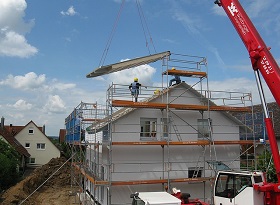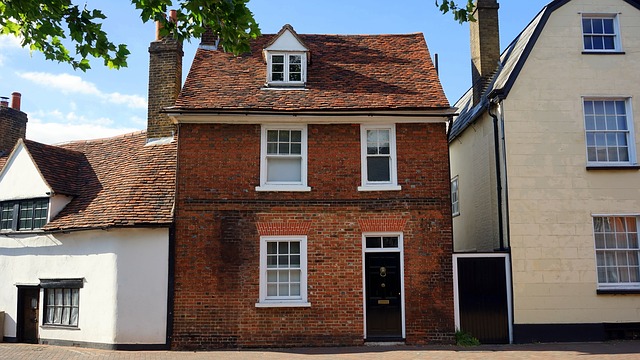House

|

|

|

|
A house is a building that functions as a type of dwelling (or domestic building) used for residential purposes, i.e. as a place of permanent or semi-permanent habitation. House style and design can range from simple huts or shacks in places like shanty towns and favelas, to multi-storey mansions containing a huge variety of amenities and services.
The social unit that lives in a house is known as a household. According to the Household Projections: England prepared by the Department for Communities and Local Government, a household, as defined in the 2011 Census is; ‘one person living alone; or a group of people (not necessarily related) living at the same address who share cooking facilities and share a living room or sitting room or dining area’.
For more information, see Household.
Conventional modern houses tend to contain the following:
- One or more bedrooms.
- Bathroom/s.
- Kitchen.
- Living room.
- Dining room.
- Building services such as plumbing, ventilation, heating, electricity, security, and so on.
Houses can be attached to outbuildings such as a garage, porch or shed, and may have a front and/or back garden, driveway, and so on.
There are a number of different types of house, including:
- A-frame house.
- Bungalow.
- Condominium.
- Cottage.
- Detached.
- Double fronted house.
- Maisonette.
- Mansion.
- Semi-detached.
- Terraced.
Traditionally, houses are built speculatively by a developer (or housebuilder), and people then buy them and move in. Homebuyers typically require a mortgage to enable them to purchase a house. This is a loan ‘secured’ against the value of the house until it is paid off over several years. There is often a sequence of homebuyers and sellers whose transactions are dependent on one another. This is known as a property chain.
Houses can also be self-built, which is where the prospective homeowner instigates the development of the house themselves, whether by purchasing a kit house, employing a design and build contractor, employing consultants (such as an architect) and a contractor, or managing the entire process and ordering all the goods and services required themselves. However, self-building does not necessarily mean that the physical construction is undertaken by the homeowner.
For more information, see Self-build homes.
There are various different forms of tenure which apply to houses, such as owner occupation, private renting, social housing and so on. For more information, see Housing tenure.
Houses are the main asset that is bought and sold on the housing market which follows the economic principles of supply and demand. When the production of housing outpaces the demand there is a housing surplus. When housing production falls behind demand there is a housing shortage.
For more information, see Housing shortage.
Since houses produce significant carbon emissions, there has been a strong emphasis in recent years on increasing their energy efficiency , both in terms of the way new-builds are constructed and the way existing houses are retrofitted. Various initiatives have been developed such as zero carbon homes, the Code for Sustainable Homes, Passivhaus and so on.
[edit] Related articles on Designing Buildings
- Affordable housing.
- British post-war mass housing.
- Building.
- Domestic building.
- Dwelling.
- Flat definition.
- Home ownership.
- Household.
- Housebuilder.
- Housing associations.
- Housing benefit.
- Housing Capacity Study.
- Housing costs.
- Housing Delivery Test.
- Housing shortage.
- Housing standards review.
- Housing white paper 2017.
- Local housing need.
- Minimum space standards.
- Residential definition.
- Smart home.
- The future of housing.
- Types of dwelling.
Featured articles and news
Infrastructure that connect the physical and digital domains.
Harnessing robotics and AI in challenging environments
The key to nuclear decommissioning and fusion engineering.
BSRIA announces Lisa Ashworth as new CEO
Tasked with furthering BSRIA’s impressive growth ambitions.
Public buildings get half a million energy efficiency boost
£557 million to switch to cleaner heating and save on energy.
CIOB launches pre-election manifesto
Outlining potential future policies for the next government.
Grenfell Tower Inquiry announcement
Phase 2 hearings come to a close and the final report due in September.
Progress from Parts L, F and O: A whitepaper, one year on.
A replicated study to understand the opinion of practitioners.
ECA announces new president 2024
Electrical engineer and business leader Stuart Smith.
A distinct type of countryside that should be celebrated.
Should Part O be extended to existing buildings?
EAC brands heatwave adaptation a missed opportunity.
Definition of Statutory in workplace and facilities management
Established by IWFM, BESA, CIBSE and BSRIA.
Tackling the transition from traditional heating systems
59% lack the necessary information and confidence to switch.
The general election and the construction industry
As PM, Rishi Sunak announces July 4 date for an election.
Eco apprenticeships continue help grow green workforce
A year after being recognised at the King's coronation.
Permitted development rights for agricultural buildings
The changes coming into effect as of May 21, 2024.





















